| | | 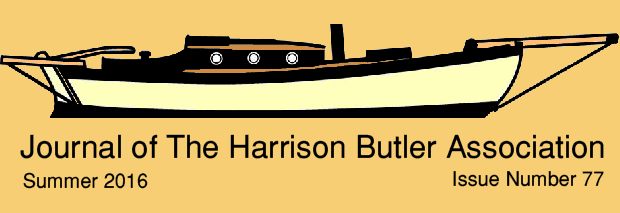
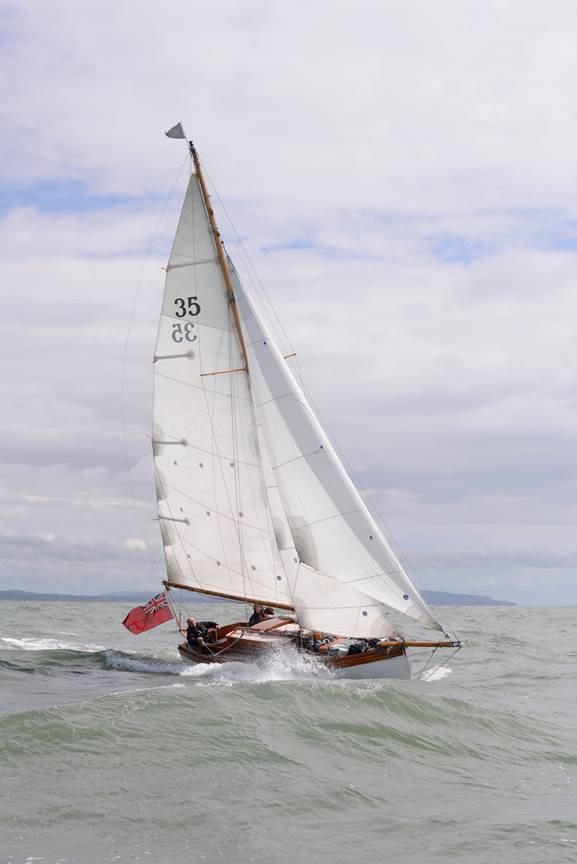
Sabrina pictured by professional photographer Rick Tomlinson
The Journal of The Harrison Butler Association
Editor : Martin Hansen
Proof Reading : Dr Helen Jones
Far East Correspondent : Dr Stephen Davies
Australian Correspondent : David Stamp
Netherlands Correspondent : Michiel Scholtes
Baltic Correspondent : Myriam Spicka
UK Correspondent for The Solent : Robert Griffiths
UK Correspondent for Dartmouth : Allen Clarke
Contributions for the Journal are most welcome be they
fully formed articles, rough notes or snippets of News.
If you feel you would like to contribute on a regular basis,
applications to join our growing network
of correspondents are also invited.

A part of the satisfaction of owning a wooden ship must surely be the DIY aspect of maintaining the boat. Wood is such a lovely material to work with; measuring, cutting, drilling, and screwing pieces together. On my home, in my youth, I developed amateur skills on Pine - the ubiquitous, fast grown, kiln dried wood that fills the nation's DIY stores. Owning a boat, however, has introduced me to the delights of working with Teak, Mahogany, Iroko, Oak, Meranti and Sapele.
One 'sods laws of boating' is that the job somehow always involves jamming oneself into a tight, small space. There's frequently not enough room around a screw head to apply an electric screwdriver, and so it's a manual task, perhaps necessitating driving the screw in at a 'more than is ideal' (aka 'wonky') angle to the perpendicular.
However, I recently discovered the world of 'stubbies' - common tools made in minimal length. The two humble screwdrivers shown are 10 cm in length, cost £1.99 each, and are utterly brilliant. I cannot believe for how many years I have struggled, and the number of jobs bodged, for the lack of this common sense solution. It may just be me, but if it's you too, buy these. They are the pleasure tool for wooden boat owners.


!•¡•! Simon Wagner, HBA Treasurer between 1995 and 1998, and past owner of Zest, has died. An obituary by Chairman, John-Henry Bowden, will be in the Autumn 2016 Journal.
!•¡•! Boats sold recently: June, Iseult, Omega of Broom and Mandamus
!•¡•! This year's HBA's Laying Up Supper is at the Oyster Inn at Pin Mill on the River Orwell on the 10th of September. Early expressions of interest are requested by email to Janet & Keith Band, our UK East Coast Social Secretary
!•¡•! Forty-three of the seventy HBA Journals published between 1973 and 2011 are how available online as PDFs. Of the remaining twenty-seven, four have been tracked down, with twenty-three currently categorized as 'lost'.
!•¡•! The champagne corks are popping at the HBA webmaster's office in celebration of being recognised as worthy of a Gold Maritime Web Award. The award is given in “Acknowledging excellence within the non-commercial maritime website community”.

The HBA website's Gold Maritime Web Award
The Hong Kong Design Boats
Stephen Davies
The HBA's Far East Correspondent

The Hong Kong Design was pivotal in establishing Harrison Butler as a creditable non-professional yacht designer. The design was published in Yachting Monthly in June 1909. Given that the design was published as “The Hong Kong Design” it seems likely to have been commissioned, but certainly it was acquired by the Hong Kong Corinthian Yacht Club (HKCYC) as a new design for their club members. Four boats were built by Ah King's boatyard, then on the Wachai waterfront in Causeway Bay, and completed in early October 1910. These are possibly the first boats built to a Harrison Butler design. The four boats, locally described as 4 ton cruisers, were;
• Brenda built for Vernon Goulborn
• Erin built for Captain Pennefather
• Evadne built for GG Wood
• Mist built for JH Taggart

Harrison Butler's Hong Kong Design of 1909, as published in Yachting Monthly
LOA 23 feet, LWL 20 feet, Beam 6 feet 8 inches, Draught 4 feet, Displacement 3.8 tons TM
For a flavour of the yachting scene in Hong Kong at this time consider the following passage taken from Gillian Chambers' book Eastern Waters, Eastern Winds;
“In 1910 the HKCYC introduced the Heywood Heyes 'Y' Class. These boats resulted from a chance meeting at a medical conference in Manila between the Commodore of the HKCYC, Dr Francis Clark, and Dr Heywood Heyes, a medical adviser to the Siamese Government and a keen yachtsman. Dr Heyes returned to Hong Kong from the conference with Dr Clark. A dinner was given for Dr Heyes by the club at the King Edward Hotel at which he stated that, if they would decide on a design, he would present the first boat built to the Club on the understanding that it should be called Siam.
“An East Coast One Design was eventually chosen from an article in Yachting Monthly, but no attempt was made to obtain the actual lines and constructional detail from the designer. Instead, these were developed from the article and taken along to Ah King for him to produce. The first boats were built in 1910 and Siam was duly presented to the Club.
“Altogether, eight of these boats were built at a cost of approximately $300 each. They were 22 feet LOA, 18 feet LWL with a six foot beam and three and a half foot draught. Rigged as gaff sloops with short bowsprits, they carried 350 square feet of canvas.

The Ah King boatyard built many wooden boats over many years in Hong Kong
This image is of the stern post from a wooden lifeboat built by the yard in 1932
Thus, in addition to the four heavier Harrison Butler Hong Kong design boats, eight lighter East Coast One design yachts were built, all at the same yard, in 1910. All four of the Harrison Butler designed boats were actively raced until 1915. Mist, was sunk in the typhoon of 1931 and by the mid 1930s, it is thought that Erin too had been lost.
Brenda was still being raced in January 1940 but she capsized and sunk when hit broadside by a squall when at anchor in the NE New Territories in April 1941. At the time she was owned by FV Jensen, manager of the Great Northern Telegraph Company in Hong Kong.
That Brenda was first owned by long time Royal Hong Kong Yacht Club (RHKYC) member Vernon Goulborn (who ran the local rope works) is interesting. That is because the next Harrison Butler design that seems to have been associated with Hong Kong - though indirectly - was in a class produced by Hong Kong amateur (but very able) designer HS 'Uncle' Rouse and Vernon Goulborn. This was the 'Typhoon' class that Rouse & Goulborn expressly say was based on the Harrison Butler Cyclone design of 1919, and which formed the very popular and successful RHKYC 'W' Class. These Hong Kong vessels were designed in 1926 and in commission by 1927. By 1939 there were ten of them in the fleet including Curlew, Monsoon, Nordwester, Penguin, Sai Long and Typhoon. It is unclear if any survived the Japanese occupation of Hong Kong between December 1941 and August 1945. From anecdotal evidence, and in spite of being in the 1947 edition of Lloyd's Register of Yachts, the suspicion is that none did. In fact, most Hong Kong yachts were either sunk by the Japanese or broken up for firewood and for their lead keels and metal fittings which fetched premium prices during wartime.
Brenda had another custodian of note in the 1920s. Paul-Augustin Lapicque owned a shipping company involved in the export of wood products and cattle from the Annam mountain range to China via Hong Kong and France. He built ports, cattle farms, a slaughterhouse, a refrigerated storage facility and a canned and salt meat factory. By 1923 PA Lapicque & Cie had built up a significant fleet. However, as a result of the general world wide collapse in the shipping economy that year he went bankrupt.
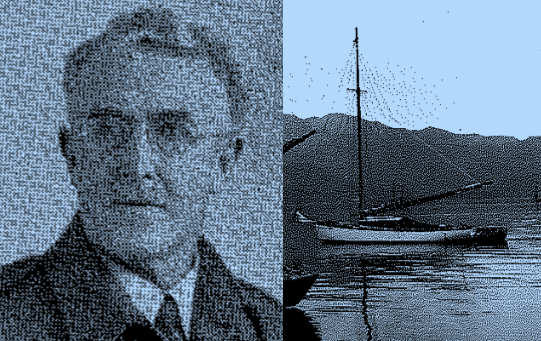
In 1912 H S Rouse (pictured) joined the Government Service in Hong Kong.
Like Harrison Butler, he designed yachts as a hobby.
Many of the pre-war fleet of over 80 yachts of the RHKYC were from his board,
including Tai Mo Shan, U & I and Golden Dragon, three that survived WWII.
His Typhoon 'W' class design was based on Harrison Butler's Cyclone design.
The yacht pictured is Monsoon, c1935, one of the 'W' class.
The fourth boat built to Harrison Butler's Hong Kong design was Evadne, built for GG Wood. He was an architect who came to Hong Kong in 1905. In 1913 he became Commodore of the HKCYC. He was a Captain in the Hong Kong Volunteer Defence Corps and served with the army in the first World War. As a result of an opium dealing/possession case in 1923 (his boat boy seems to have been the culprit) it is known that by that date he owned a yacht called The West Wind. It seems probable that between the last known mention of Evadne in 1918, and the ownership of The West Wind in 1923, Wood sold Evadne and whoever bought her renamed her Isis. One possible reason for the renaming is that until the 1906 typhoon, when she was sunk, there had been a very actively sailed ketch called Isis. The Isis built to Harrison Butler's Hong Kong design is first mentioned in 1923 when she was owned by Captain F Brown who, two years later, sold her to S Feltham. The last known mention of Isis is from a racing event in January 1940.
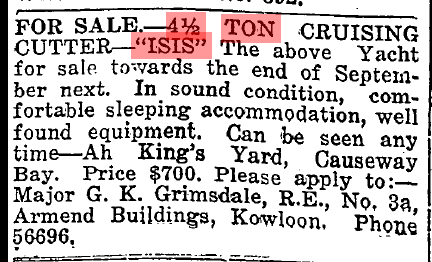
An advertisement offering Isis for sale, July 21st, 1933
Major GK Grimsdale should read Major GE Grimsdale (Royal Engineers)
GE Grimsdale later played a key 'intelligence' role in the East in WWII
The final Harrison Butler associated with Hong Kong was a 6 tonner, a Bermudan sloop, being built by Ah King in April 1939 at his new yard in Causeway Bay for a Major Way. No details are given about design type, solely that it was 25 feet LWL, 32 feet LOA, 8 feet 9 inches beam and 5 feet draught and around 6 tons measure. What happened to this boat is not known.
There is a rumour that the aged Ariki III here in Hong Kong, sister to the Scots based Nordica (ex Ariki II), is a Harrison Butler design. Both were completed just before the war by Ah King, scuttled and postwar raised and put into commission. Neither is an Harrison Butler design. Both were to the same design by American designer Ralph E. Winslow, although it has yet to be established which design.

In this photograph from 1937, the lettering “A King” is visible on a building
above what looks like slipways and boat building sheds.
For discussion of this image visit The Industrial History of Hong Kong website.
Seasalter Boat-Spotted
Tom Riddell
I was one of five children. Our parents kept a converted navy cutter in Westernport Bay, Victoria, Australia, which we stayed on at the weekends and for holidays during the 1960s. We regularly overnighted at the town of Hastings because it was very sheltered by the access channel winding through mudflats. There were about 30 or 40 boats moored along the channel, nearly all small yachts and fishing boats, with the one exception - Seasalter. She had a blue hull and no bowsprit in those days. She looked fabulous and we used to admire her every time we stayed there.
Now, fifty years later, my sister in law Maree and two of my brothers Viv and Geoffrey tell me that they have just spent a couple of weeks moored next to Seasalter in Noumea on Grande Terre, New Caledonia in the Pacific Ocean - one of the most isolated places in the world. They had a chat with custodian Jay Lawry about the marvellous restoration he has carried out upon her, and his current voyage from New Zealand to Australia. They watched her head out, on her way to cross the Coral Sea to Cairns, Queensland. As she left Noumea, Geoffrey took the attached photograph, May 2016.
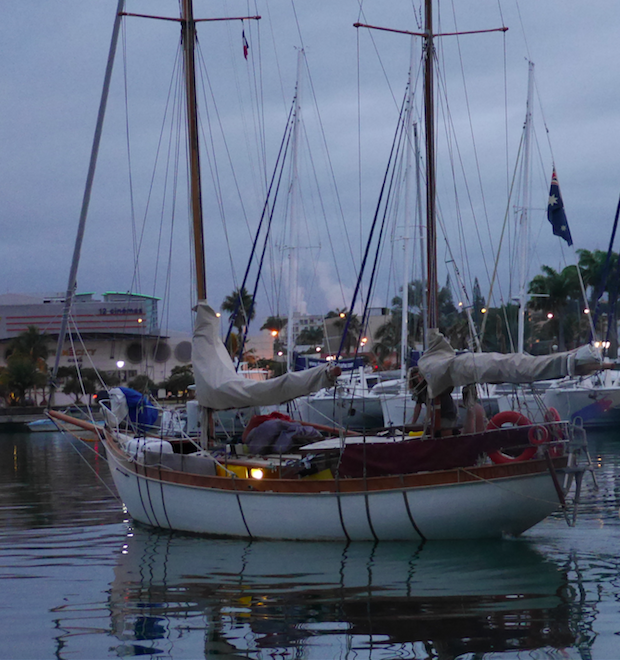
Geoffrey Riddell recognised Seasalter from a childhood memory.
Seasalter's progress can be followed on this chart.
Mischief III Races Around The Island
Craig Nutter
The HBA's Press Officer
This image is of Mischief III racing past Cowes on the Isle of Wight in the Round The Island Race 2016. She is the front boat of the pack of three. I took the photograph from my bedroom window using an iPhone through the lens of my binoculars.
Mischief III was crewed for the race by Paul, Jane and Will Barnes. They crossed the start line in company with Gypsy Moth IV on a blustery day. After an exciting race, on corrected time, they finished just behind her. I'm very proud of them.
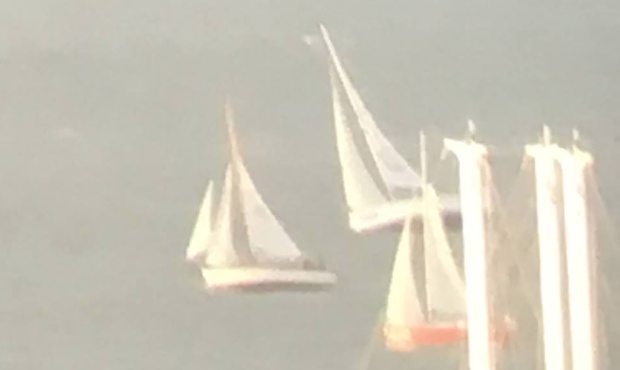
Mischief III racing in the Solent, July 2nd, 2016
Photograph by Craig Nutter
Sage Cruises Canadian West Coast
Sterling Chew
Over the last month Sage has sailed from Tenakee in Alaska to Bellingham in Washington State. The boat has been impressive - in the Pacific Ocean she steered herself on every point of sail. My girlfriend set a new “Sage personal best speed” of 9.0 knots on the GPS, without surfing. We spent two weeks at Calvert Island, 100 km North of Vancouver Island, and I can't tell you how much we enjoyed that place. A 'must stop' for anyone traveling the Pacific Northwest.
Sage is now moored in Blaine Harbor, on the border between Canada and the USA, until our return in October for a long winter cruise along Puget Sound and North to Quadra island.
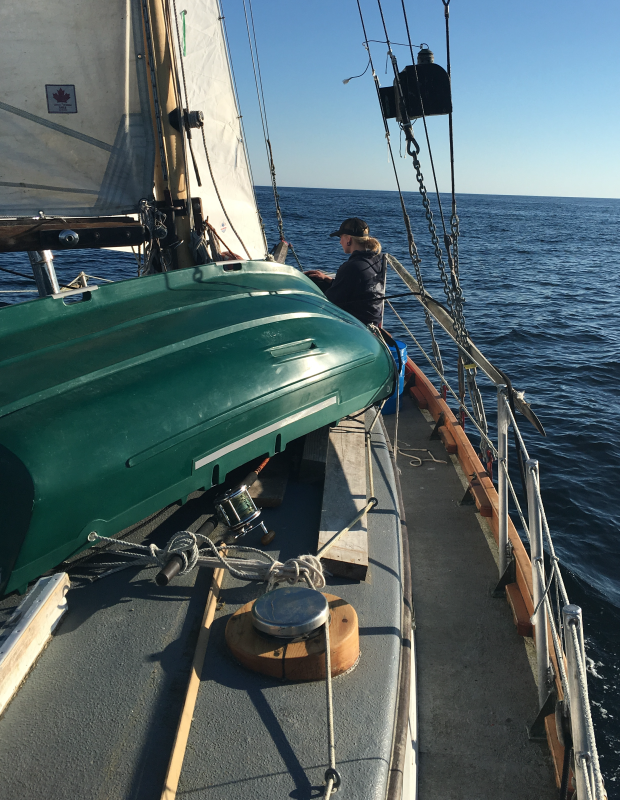
Built to Harrison Butler's Khamseen A design,
Sage is cruising the Pacific Northwest coast of Canada
Ganga Devi - Part II
~ Big Blow ~
Previously : Part I
JOC Alexander
To the accompaniment of 'Scotland the Brave', the Regimental March of Gurkha Signals, Ganga Devi's Main and Genoa were set. She crossed the start line of the Royal Hong Kong Yacht Club to a single cannon blast at 9.20 am on 1st December 1960. The destination was Singapore, 1700 miles South through the China Sea. With me were Hugh Burt and Rupert French. Ganga Devi, our Harrison Butler designed sloop, was soon through the Lyemun Gap and rolling heavily in a moderate swell in the Tathong channel. All three of us were seasick. Our second day at sea dawned cold and cloudy with rain showers. A light North Easterly enabled us to set twin Genoas, the sheets being brought back to the tiller. This worked well, in that the boat self steered, but created a sickening roll as we yawed off course one-way and the other; not good for tender stomachs. The ship's log for that evening records that our first hot meal was eaten as we made four knots in the desired direction under a clear starry sky. During the next day and night the wind increased to Force 8. A confused, angry sea of high waves built up. Most discouraging were the breaking crests that occasionally smashed across the decks. All sail was taken down and we ran downwind under bare poles.
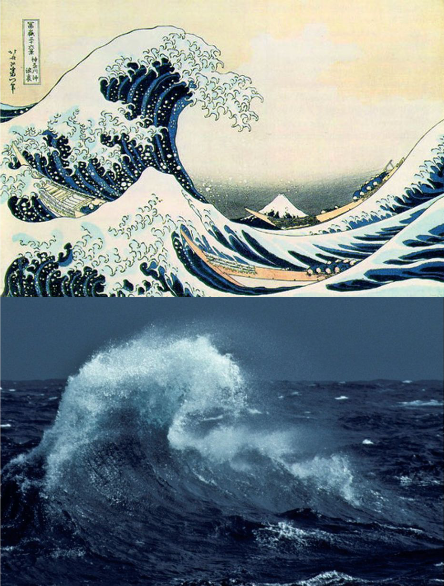
Upper : The great wave off Kanagawa woodcut by Katsushika Hokusai
Lower : Southern Ocean rogue 5 metre wave photographed by V Sarano in 1991
Freak waves possess height and steepness much larger than those in their neighbourhood
By 5th December the gale was blowing harder, the sky an evil dull yellow, and the sea state horrendous. Solid water and salt spray made life in the cockpit unendurable. It was cold. The sea anchor was deployed on 200 metres of 2-inch nylon, first from the bow, but then, as Ganga Devi didn't lie well to that, from the stern. Exhausted, the tiller was lashed and all went below at dusk to try and rest. There are not the words to convey the living hell of that night; terror at the noise of seawater pounding violently into the side of the boat and the severe jolts as repeated breaking crests submerged us. It was pitch dark - neither the paraffin cabin lights nor the stove could be lit. We were very worried.
Come the morning of the 6th, Ganga Devi was hit particularly hard by a wave that smashed one of the coach roof deadlights. The three of us charged on deck to find that it had also bent the steel boom crutch flat across the cockpit, flattened two stanchions, stripped some of the running rigging off the mast and filled the so called 'self draining' cockpit. The whole boat felt sluggish and it was clear that, unless energetic measures were taken, the boat would sink stern first. Rupert seized the bucket and bailed the cockpit, Hugh got physical with the bilge pump and I crawled under the companionway steps to confirm a suspicion; the stern compartment was full of water that had entered through the cockpit locker lids. I then realised that the steel bulkhead between the cabin and stern space had no limber hole, so that the water could not drain into the pump well. Hanging head down in the gloom under the cockpit, Hugh and I had to cut a hole with a cold chisel in the steel bulkhead. It was no easy task. Meanwhile, it was necessary to man the helm at all times to keep the boat head on to the seas and so protect the cockpit as much as possible from the breaking waves.
By noon Ganga Devi was fighting to stay afloat in a typhoon; gusts of 100 knots, seas 30 to 40 feet in height, and multiple vicious breaking crests all around. We'd had no hot food or drink for over 36 hours. Everything was soaked. A survival bag was packed and we had discussed how we would abandon ship, if necessary. Navigation was guesswork but we had probably been driven 300 miles South despite the drag of the sea anchor. That we avoided both the Spratley and Parcel Island groups was down to luck.
Eleven days after leaving Hong Kong, on the 12th, the storm abated. For the first time since the maelstrom started we had some say about our fate. Morale lifted as, in good weather, we were able to press on for Singapore. At midday on the 17th of December 1960, we made port. We had passed through watery hell but had lived to tell the tale.
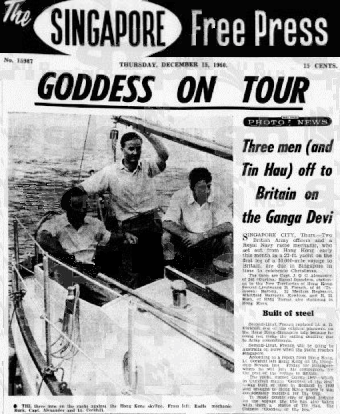
The Singapore newspapers picked up on the lucky charm, Tin Hau, carried aboard
and the fact that Ganga Devi translated as Goddess of the Sea in Gurkhali.
To be continued...
Antique Design Drawing For Sale
Allen Clarke
The HBA's UK Correspondent for Dartmouth
In a small antique shop in Dartmouth, a framed drawing of the Khamseen design is for sale for £220. The drawing looks original and is signed “Harrison Butler” along with the date “1930”.

The Khamseen design was published in January 1931 in Yachting Monthly and five boats have been built to this design. The Association has professionally digitised, high resolution, images of this design available, spread across four drawings, at a cost of £80 to members. So what is being paid for is one of the four drawings of the design and the fact that it was produced in 1930 and is signed. It is being sold by M & H Antiques . Confusingly, Harrison Butler produced a different design, the Khamseen A, in 1941.
.png)
The framed antique print of Harrison Butler's Khamseen design
currently for sale by M & H Antiques of Dartmouth, £220
Storm In A Tea Cup
Fran Hansen
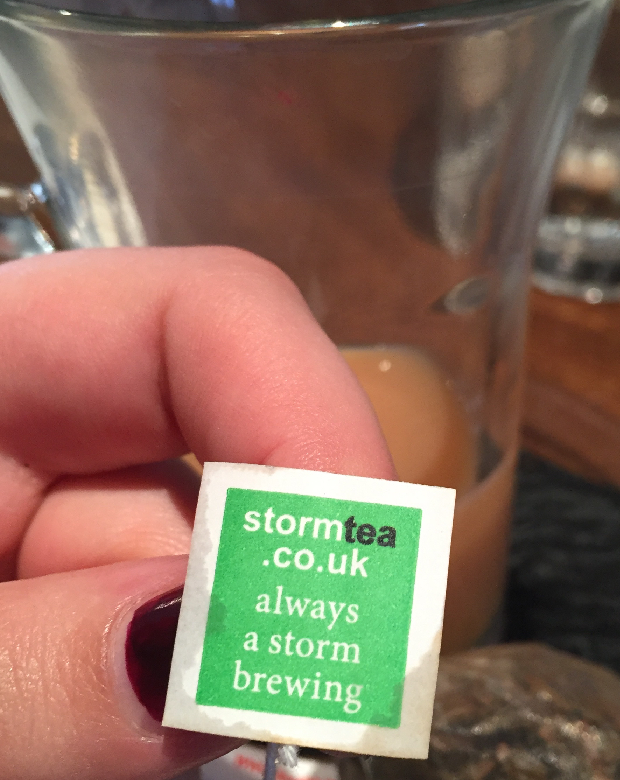
As served up in Jamie Oliver's restaurant, Bath.
A follow up to last issue's Coffee Break
Tramontana Limps Home
Martin Hansen
The HBA's Webmaster & Journal Editor
I've twice been in the Irish Sea in a Force 8. The first time, in 1977, was as a Sea Cadet on a Royal Navy Leander Class frigate. At 3 am I watched from the bridge as a line was fired across to a dismasted yacht, her decks awash, her hull holed by her own mast, pulled back in to mortally pierce her side by a tangle of her own rope rigging and steel shrouds. Under powerful searchlights her crew were winched off, the yacht then sinking. The swell, rolling in from the Atlantic, was vicious. I have a memory of being violently sea sick in the heads, somewhere towards the bow of the ship, as the frigate's Captain, over the tannoy, praised his crew on successfully locating the sinking yacht in difficult conditions and rescuing her crew.
My second Irish Sea Force 8 was in 1996, as a teacher with a school group of ten pupils on an Ocean Youth Club yacht, sailing out of Liverpool, bound for Skye, where we would later climb the Cuillin mountains. Not on watch, from my bunk, I opened an eye to see a bag of sugar somehow flying 'upward' across the cabin to explode on the bunks and occupants opposite, my gaze then following the cloud of sparkling powder as it joined a mass of crockery, cutlery, clothing and footwear all strewn about the cabin sole. As I say, it wasn't my watch. I closed my eye and went back to sleep.
These two incidents instilled in me a great respect for the Irish Sea, which, from a chart, one could be forgiven for thinking is simply a large boating lake, sheltered by Ireland on one side, Wales and England on the other, and narrow exits top and bottom. It was thus with some incredulity that I found no wind what-so-ever as Tramontana crossed this sea from Belfast to Conwy, late August 2015. Over smooth water, it's surface a glassy sun bathed calm, I and crewmate Guy Holmes guided our engine powered vessel. As Conwy, our destination, approached we should have been relaxed, but were extremely tense. The clutch in our gearbox was slipping, and on full ahead Tramontana could manage 2 knots amidst clouds of pale grey diesel exhaust. By careful management of the situation we would arrive in Conwy about one hour before high tide, but the prospect of being carried in on a 5 knot current was panic inducing, not least because the Conwy Marina entrance was at right angles to the estuary current. It defied the laws of physics to turn Tramontana's 17 ton weight through 90° at the correct moment to cut across the five knot stream and through the 10 metre wide entrance. In her enfeebled state she would be slow to respond to any request for a change in direction from the rudder, being carried steadily down stream all the while she turned.

With no wind, our sails would not save us, but the anchor might. It was made ready to drop. We had no wish to be swept into the low bridge across the river a couple of miles past the marina. If we used the anchor we'd probably end up high and dry and precariously on our side on the mud flats at low tide although there was some deep water just before the bridge if we dared to leave our emergency plan until the last minute, and the anchor gripped the mud quickly and without dragging.
I began formulating a response to my insurance company in anticipation of being asked why the boat had been written off but the coastguard not called. My answer revolved around the likelihood of there either being a back eddy or sufficiently weak flow in the two football pitches worth of water covered mud flat opposite the marina entrance. If I could somehow pause Tramontana there for half an hour, high-tide slack water would arrive and we'd have a still water opportunity to either get into the marina or tie up to a moored boat or mooring buoy.
As anticipated we surged past the marina on a five knot current and concentration focussed on crossing through the two rows of moored boats sitting in the current to get into what looked like calmer water off to port. We narrowly missed one parked yacht, and dodged a large moving motorised cruiser powering at full throttle into the current on its way out to sea. The water covered mud flats were indeed an area of reduced and assorted currents although it proved impossible to 'ferry glide' in a stationary location and as we edged seaward it became necessary to turn into the current again, whizz past the marina again, and cut across the moored rows of boats again.
As if by magic, at two minutes to high water, the current suddenly ceased to flow. This was our chance. I no longer cared if the engine blew up due to excessive revs. We charged at our full speed of two knots for the gap into the marina. Just inside an empty hammer head beckoned. We headed straight for it. It was such a relief as Guy confidently stepped onto the pontoon and secured a line. We were home.

Thirty photographs from Tramontana's voyage to the West Coast of Scotland
are available to view on the Tramontana.Voyage website

Charles Chambers
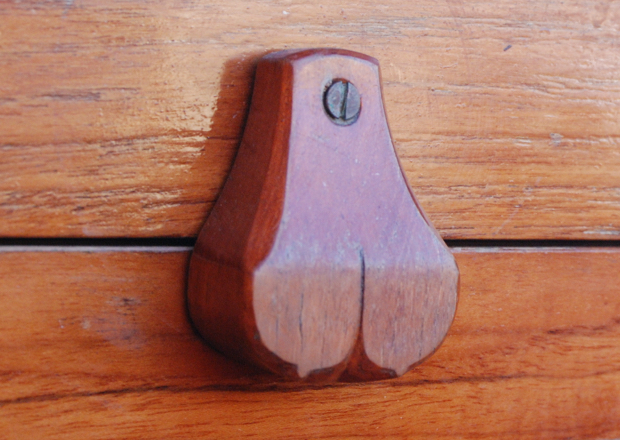
This artistic locker catch was carved by Luke Powell
and is to be found aboard the Waterbug Veritia

A post UK EU Membership Referendum fall in the value of the Pound against the Euro of around 12%,
means that those boats priced for sale abroad may well now have higher UK Sterling asking prices.
HB = Harrison Butler Designed
AS = Albert Strange Designed
IF = Invited Friend - The link will give designer detail
Cyclone : HB Cyclone Design : 1941 : Netherlands : £11,500
Jane : HB Bogle Design : 1939 : Cornwall, UK : £10,000
Jolanda : HB Omega Design : 1996 : Germany : £27,000
Kelana : HB Z4 : 1939, Brighton UK : £300
La Bonne : HB Nursery Class : 1919 : Devon, UK : £POA
Leona : AS : 1906 : Yorkshire, UK : £8,500
Mytica : HB Paida Design : 1941 : Ayr, Scotland : £5,000
Omega of Broom : HB Omega Design : 1939 : Tollesbury, UK : £15,000
Saltwind : HB Z4 : 1940 : Spain : £16,000
Sea Harmony : AS : 1937 : Massachusetts, USA : £25,000
Senorita : HB Cyclone II Design : 1934 : New Zealand : £4,000
Spindle : IF : 1983 : Plymouth, UK : £5,000 (open to offers)
Tamaroa : HB Thuella Design : 1973 : £9,000
Tally Ho : AS : 1909 : West Coast, USA : £25,000
Thalamege : HB : Netherlands : £6,750
Thule : HB Yonne Design : 1934 : Netherlands : £15,000 -£18,000
Witte Walvis : HB Z4 : 1939 : Netherlands : £5,000
Zebedee : HB Z4 : 1938 : Ireland : £4,750
Zephon : HB Z4 : 1950 : Shetland, UK : £4,500
As Pretty As A Postcard
Lee Shore
The postcard shown below was being auctioned on eBay earlier this year. I snapped it up for £2 as I recognised the boat - It's Jane, built to Harrison Butler's Bogle Design of 1934, the 'raised eyebrow' dog house being a unique feature of this particular boat. Jane is For Sale through the Classic Yacht Brokerage for £10,000.
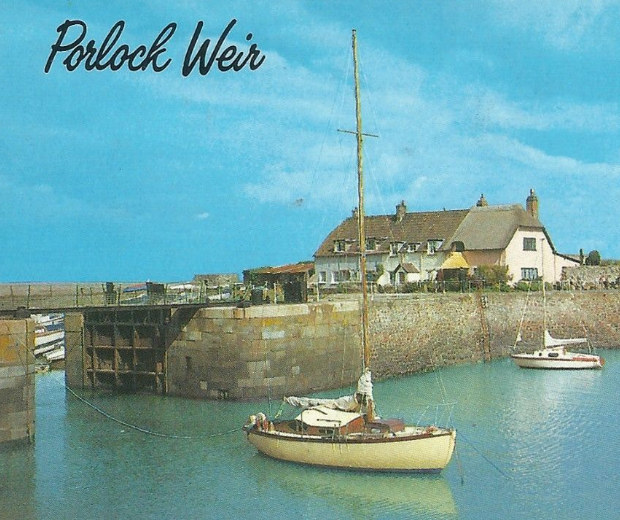

| |